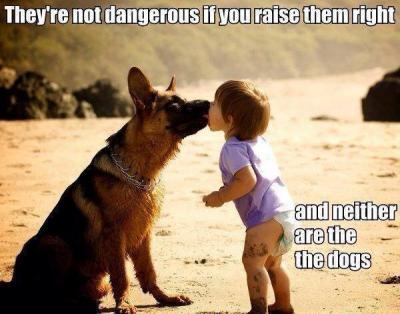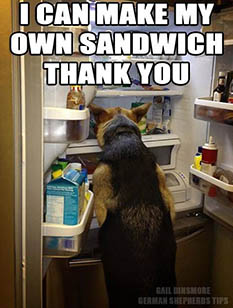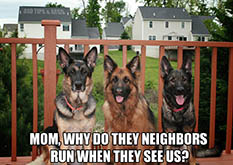BEHAVIOR MODIFICATION
- Saturday, August 23 2014 @ 05:09 pm UTC
- Contributed by: erik
- Views: 2,209
We are always asked about the value and function of training to correct bad habits, so here is one way of looking at that. All of the GSD's we accept into rescue have good to great temperaments. Temperament is not synonymous with training nor does one substitute for the other. If you have a trained but wild dog, or if you have a wild untrained but sweet dog, you have issues that must be addressed. Temperament means that the dog has the stability to learn but regardless of how the dog has been trained, if he is prone to aggressive or bad behavior he probably would not be accepted by us into rescue. We take dogs that are safe, not aggressive nor prone to resource guarding, overly protective or unpredictable. We try our best to sort out their level of stability which, as i describe it, puts them in the green zone and ready to train rather than in the red unpredictable zone where training may or may not take as quickly.
Dogs that have issues such as jumping, shyness, mistrust, hand shyness or have some fear of things such as other aggressive dogs, men with hats, quick or sudden moves or loud noises like thunder are correctable with behavior modification type training. The reason we put all new adopters into training school is to provide them the resource to ask about these issues and begin to correct them in addition to learning the normal commands from their new owner. before a dogs behavior can be modified, he does need to respect the new owner and to develop a trust that only time can solidify.
First jumping. Jumping is something that if not corrected in a puppy becomes far more difficult to treat as an adult or adolescent dog. The best course of action with jumping is to never reward the behavior by petting him, simple turn away, fold your arms and say emphatically "no jump" and mean it. Do not hit him, but make your voice create the negative feedback. If he is on a lead, provide an instant correction and then by voice, say "no jump'. If the dogs jumps on others and not you, correct the behavior immediately by a snap on his collar showing him that the behavior is unacceptable. Make sure the person who he jumps on is not going to respond positively but rather turns away or screams in a loud squeaky way to show him that they are displeased. Repeat the process by taking him among friends and do the correction each time he jumps and misbehaves until he expects a negative feedback on any jumping. Most behaviors can be changed or modified by consistent responses so that regardless of the bad habit, a repetitive negative reaction to that behavior begins to change the dogs desire to receive positive feedback with his new owner rather than a negative response.
Shyness is corrected by allowing your dog to interact with others, under your supervision, in a way that creates a positive situation each time he meets a new person. A good way to accomplish that is giving the new person treats to give to the dog. he he will not take treats from strangers you need to intercede by telling him in a calm positive tone of voice how good he is and pet him while the new person is also petting him on a lead. Reassure him that all if OK and that meeting new people is a good thing. Repeating this with those in a mall, pet store, at home or at the park reassure him that people are a positive thing and that getting praise when he does allow people to pet him is a pattern he will want to repeat. This also is a good way to address hand shyness because treats always come from these new people and from his new owner. Try to make the dog look people and of course the owner in the eye (eye contact is critical to effective training) and by doing that he can begin to understand that hands bring good things and not always bad things. Be careful with hand shy dogs with kids because they surely don't understand the issue or the corrective action and you don't want to have an accident. Accidents are usually handler error, so be aware that you are responsible for your dog and that you need to learn to read him as he will in most any situation. You need to be on top of his actions and of course alpha to him in the pack. GSD think all of the time and they have little tolerance for wishy washy behaviors by their owners. Either you decide how to act right then and there or they will.
Meeting and greeting new people, new dogs and being in new situations while under the control of the owner makes for a secure dog. If you are afraid of people so will the dog. If you are scared by lightening, so will the dog. The leash is a conduit to your heartbeat and your brain and your GSD can read that like a book. To change behaviors you too need to change your way of doing things. With lightening and thunder especially, sitting calmly with your dog is helpful. Distracting him into doing something he likes can help him forget about his fear because he may like the activity you are doing, such as playing ball or eating, better than he like the fear sensation he gets from the noise. No all behaviors can be change and surely none of these ingrained behaviors change in an instant. All behavior modifications need time and consistency and all need to come from the top down in the pack. Look to yourself to start the process and ask your trainer or us for help when needed.
Don't let bad behaviors spoil the relationship with your dog because if that happens we will be getting him back in worse shape than when he left here. Be kind and consistent with making changes because only in this way can the behaviors be changed. A dog needs a reason to change, substituting one behavior for another works best. Dogs don't come with sim cards and they cannot be programmed without repetitive behavior modifications techniques. Training takes time but if it is fun the time is well spent. Training is a bonding experience and one that can provide fun and mental stimulation to your pet, so use the time training to bond and to correct bad habits. The more time spent doing that initially the better life you will have with your pet and the better time your pet will have with you. Love is not instant, but learned over time, so use that developmental process to your best advantage.



Dogs that have issues such as jumping, shyness, mistrust, hand shyness or have some fear of things such as other aggressive dogs, men with hats, quick or sudden moves or loud noises like thunder are correctable with behavior modification type training. The reason we put all new adopters into training school is to provide them the resource to ask about these issues and begin to correct them in addition to learning the normal commands from their new owner. before a dogs behavior can be modified, he does need to respect the new owner and to develop a trust that only time can solidify.
First jumping. Jumping is something that if not corrected in a puppy becomes far more difficult to treat as an adult or adolescent dog. The best course of action with jumping is to never reward the behavior by petting him, simple turn away, fold your arms and say emphatically "no jump" and mean it. Do not hit him, but make your voice create the negative feedback. If he is on a lead, provide an instant correction and then by voice, say "no jump'. If the dogs jumps on others and not you, correct the behavior immediately by a snap on his collar showing him that the behavior is unacceptable. Make sure the person who he jumps on is not going to respond positively but rather turns away or screams in a loud squeaky way to show him that they are displeased. Repeat the process by taking him among friends and do the correction each time he jumps and misbehaves until he expects a negative feedback on any jumping. Most behaviors can be changed or modified by consistent responses so that regardless of the bad habit, a repetitive negative reaction to that behavior begins to change the dogs desire to receive positive feedback with his new owner rather than a negative response.
Shyness is corrected by allowing your dog to interact with others, under your supervision, in a way that creates a positive situation each time he meets a new person. A good way to accomplish that is giving the new person treats to give to the dog. he he will not take treats from strangers you need to intercede by telling him in a calm positive tone of voice how good he is and pet him while the new person is also petting him on a lead. Reassure him that all if OK and that meeting new people is a good thing. Repeating this with those in a mall, pet store, at home or at the park reassure him that people are a positive thing and that getting praise when he does allow people to pet him is a pattern he will want to repeat. This also is a good way to address hand shyness because treats always come from these new people and from his new owner. Try to make the dog look people and of course the owner in the eye (eye contact is critical to effective training) and by doing that he can begin to understand that hands bring good things and not always bad things. Be careful with hand shy dogs with kids because they surely don't understand the issue or the corrective action and you don't want to have an accident. Accidents are usually handler error, so be aware that you are responsible for your dog and that you need to learn to read him as he will in most any situation. You need to be on top of his actions and of course alpha to him in the pack. GSD think all of the time and they have little tolerance for wishy washy behaviors by their owners. Either you decide how to act right then and there or they will.
Meeting and greeting new people, new dogs and being in new situations while under the control of the owner makes for a secure dog. If you are afraid of people so will the dog. If you are scared by lightening, so will the dog. The leash is a conduit to your heartbeat and your brain and your GSD can read that like a book. To change behaviors you too need to change your way of doing things. With lightening and thunder especially, sitting calmly with your dog is helpful. Distracting him into doing something he likes can help him forget about his fear because he may like the activity you are doing, such as playing ball or eating, better than he like the fear sensation he gets from the noise. No all behaviors can be change and surely none of these ingrained behaviors change in an instant. All behavior modifications need time and consistency and all need to come from the top down in the pack. Look to yourself to start the process and ask your trainer or us for help when needed.
Don't let bad behaviors spoil the relationship with your dog because if that happens we will be getting him back in worse shape than when he left here. Be kind and consistent with making changes because only in this way can the behaviors be changed. A dog needs a reason to change, substituting one behavior for another works best. Dogs don't come with sim cards and they cannot be programmed without repetitive behavior modifications techniques. Training takes time but if it is fun the time is well spent. Training is a bonding experience and one that can provide fun and mental stimulation to your pet, so use the time training to bond and to correct bad habits. The more time spent doing that initially the better life you will have with your pet and the better time your pet will have with you. Love is not instant, but learned over time, so use that developmental process to your best advantage.


